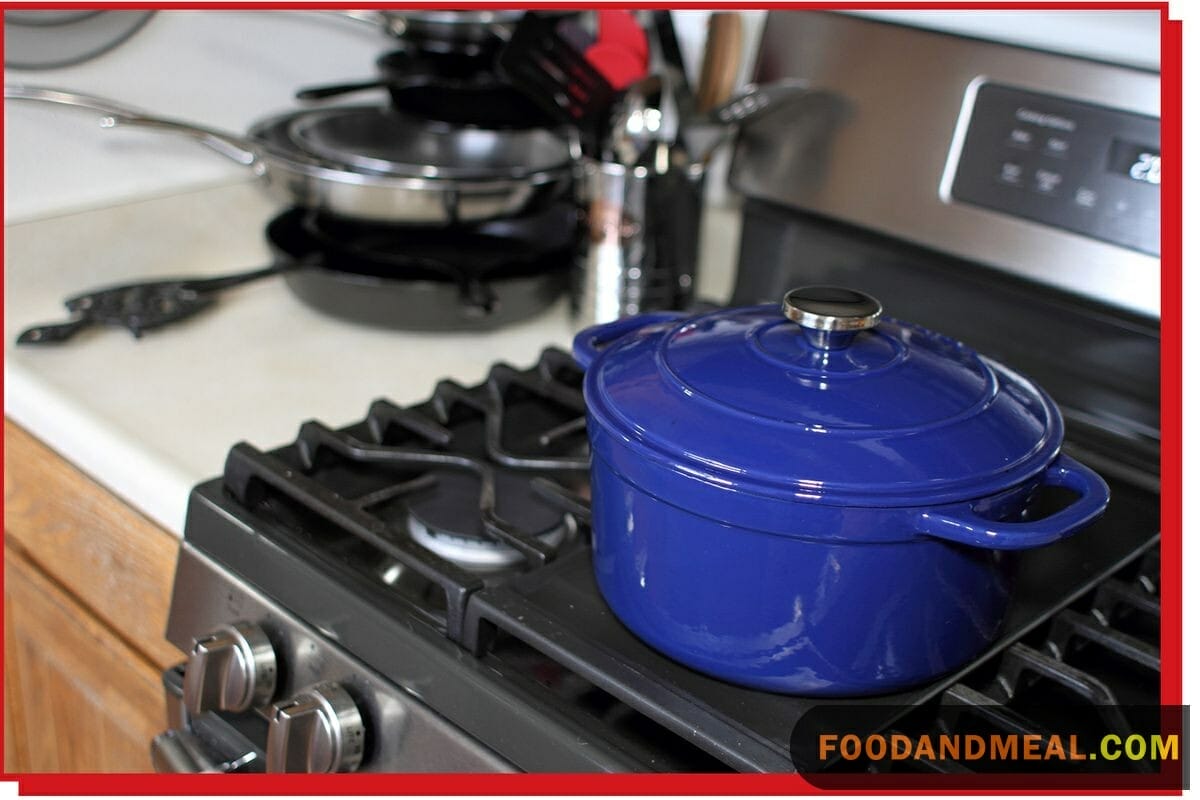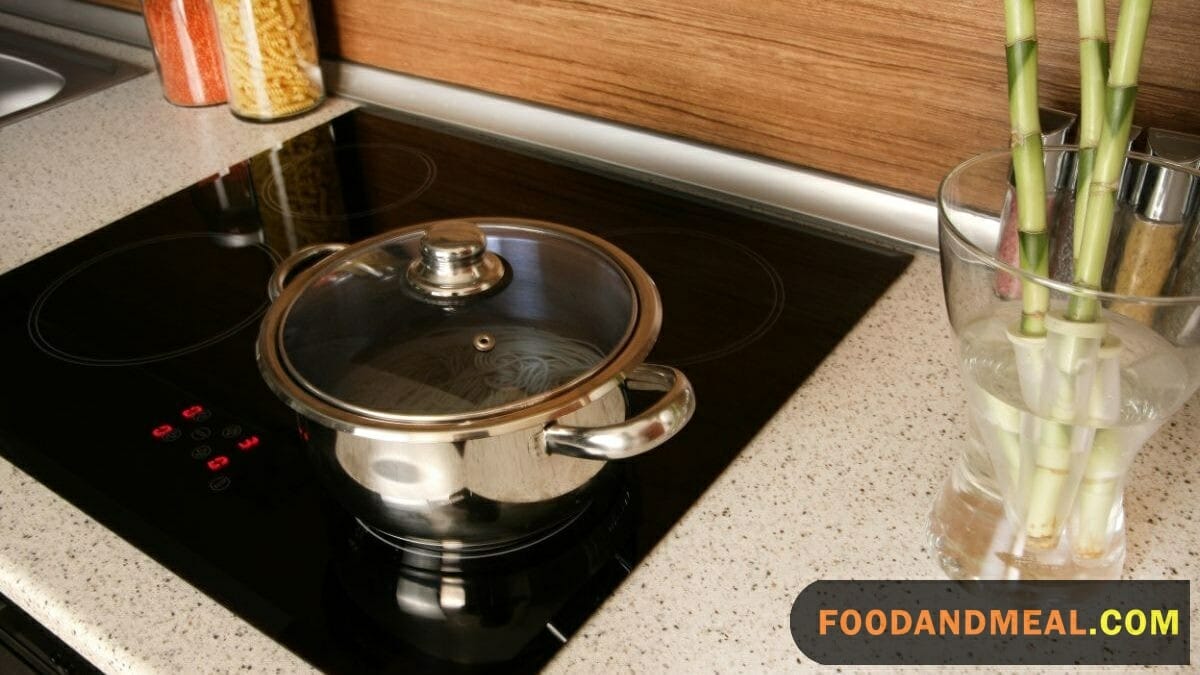Although cast iron and aluminum are suitable for stovetop use, ceramic and stoneware Dutch ovens do not fare well on stovetops. Additionally, specific precautions need to be observed when employing a Dutch oven on gas, electric, glass, or induction stovetops. Keep reading to discover comprehensive information about your Dutch oven and its application on various types of stovetops. So, Can You Use a Dutch Oven on the Stovetop?, Let’s find out through the following article of Food and Meal!
What is a Dutch oven?
The Dutch oven holds a special place in the hearts of Americans, cherished for its versatility in the kitchen.
Did you know? Cast iron Dutch ovens have been highly prized since the 18th century and were even mentioned in people’s wills!
In this indispensable kitchen tool, you can bake, broil, roast, simmer, fry, and create delectable casseroles, risotto, soup, curries, and stews. Its exceptional heat retention capabilities make it a versatile cookware choice for all types of recipes.
- Therefore, we researched and tested 30 types of dutch ovens and selected the 9 best dutch ovens according to the criteria of size, durability and color. Read more here: https://foodandmeal.com/the-8-best-substitutes-for-dutch-ovens

Today’s market offers Dutch ovens crafted from various materials. The most prevalent choice is enameled cast iron, although aluminum and magnetic stainless steel also enjoy popularity. Before you place your Dutch oven on any stovetop, the first imperative step is to carefully read the manufacturer’s instructions. Adhering to these guidelines will spare you from potential complications.
Take note: Ceramic or stoneware Dutch ovens are specifically designed for baking and should never be exposed to stovetop heat. Heating them this way could lead to cracking. This phenomenon occurs due to uneven expansion caused by varying distances from the heat source. The result is an imbalanced temperature distribution that may cause the Dutch oven to fracture when used on a stovetop.
Using Dutch Oven on a Gas Stovetop
Your Dutch oven will securely sit on the burner hobs, providing a shield for your stovetop from its substantial weight.

No need to fret about an uneven bottom. The surrounding hobs around the flame ensure an even distribution of heat across the bottom surface. Keep in mind that due to the open flames on a gas stovetop, your Dutch oven will rapidly heat up compared to other types of stovetops.
To prevent scorching when using a Dutch oven, consider reducing the cooking time or adjusting the temperature to medium-low. Once heated, the Dutch oven retains its warmth even at lower temperatures, so it won’t cool down quickly. For using Dutch ovens on a gas cooktop, the key is a slow and steady approach.
Using Dutch Oven on an Electric Stovetop
Electric stoves feature electric plates equipped with a heating element underneath.
The heating element of the electric burner remains well-protected, alleviating concerns about the Dutch oven’s bottom causing any damage to the stovetop surface. Remember to maintain a medium heat setting while cooking.

Using Dutch ovens on an electric stovetop involves a gradual process. It requires more time to reach the desired temperature. To prevent uneven cooking, transition the heat from medium to low. Thanks to its impressive heat retention capabilities, the Dutch oven will sustain cooking under the same heat level.
Using Dutch Oven on an Induction Stovetop
Any ferromagnetic material (such as those containing a good amount of iron or magnetic stainless steel) performs exceptionally well on induction plates by allowing magnetic waves to permeate the pot. Induction cooking operates by creating a magnetic field that generates heat within your Dutch oven.
Induction stovetops are particularly suited for cast iron and enameled cast iron Dutch ovens, with the caveat that they shouldn’t have a rounded bottom. Opting for induction stovetops with Dutch ovens offers significant energy savings. Only the area beneath the Dutch oven heats up, leaving the rest of the surface cool to the touch.

Furthermore, food cooks faster on an induction stovetop compared to other types of stovetops. Be mindful that induction can rapidly reach high temperatures. It’s advisable to cook on low to medium heat to avoid the Dutch oven’s bottom from scorching. Avoid exposing the induction stovetop to sudden extreme temperature changes.
Achieving gradual and consistent heating is the secret to effectively utilizing a Dutch oven on an induction cooktop. For safeguarding your glass surface from the Dutch oven’s rugged bottom, consider using Silpat mats or parchment paper between the Dutch oven and the induction burner.
Ensure that any food debris is removed, as it might stick under the Dutch oven and disrupt proper cooking. Among the contemporary stove-top options making their way into American households is the modular stovetop. This innovation consolidates all heating elements into one unit. Incorporating an induction burner, a gas burner, and an electric burner, the modular stovetop provides a versatile platform for Dutch ovens.
Precautions to Take While Using Dutch Oven on a Stovetop
Gradually warm up your Dutch oven by allowing it to heat slowly. Maintain the burner at a low to medium flame when cooking, including tasks like browning and searing. Never put an empty Dutch oven on the stovetop, as this can lead to burning the bottom. Instead, add a small amount of oil or water and gradually heat the Dutch oven. Ensure all your ingredients are prepared beforehand – peel and slice them in advance.
When boiling water or reducing sauces, progressively increase the temperature to high. Maintain it at high heat for a brief period and then reduce the heat. For sauces, curries, and soups, after the Dutch oven is properly heated, lower the temperature to a simmer and cover the pot until the cooking process is complete. To prevent sticking and uneven cooking, periodically open the lid and stir the ingredients. It’s not recommended to preheat a Dutch oven directly on a stovetop. Instead, let the Dutch oven come to room temperature before placing it over low heat on the stovetop.

Avoid exposing the Dutch oven to abrupt temperature changes, as these can cause expansion and contraction of the metal, potentially damaging the surface. To prevent scratches on glass cooktops, always lift and place the Dutch oven; avoid sliding it. Be cautious not to drop the Dutch oven on the stovetop. Utilize stable kitchen gloves to lift and move it to and from the stovetop. Always clear away food residues before positioning your Dutch oven on any type of stovetop. Neglecting to remove food particles can result in burning and staining the stovetop.
After use, wash your Dutch oven with warm soapy water. Due to its quick absorption of food and oils, thorough cleaning is essential to eliminate previous food odors. Opt for a classic indoor Dutch oven instead of an outdoor version with legs. The latter is better suited for coal fires and campfires. Check for any cracks in the Dutch oven before placing it on the stovetop. Also, ensure that the enamel lining is not chipped to prevent glass from mixing with your food. Keep in mind that the Dutch oven will be quite hot after cooking. Use kitchen gloves to safely lift it from the stovetop.
Tips on Cooking Styles Using a Dutch Oven on a Stovetop
When aiming to thicken gravy or achieve a dry roast on your meat, opt to remove the lid from your Dutch oven instead of raising the temperature. For the most delectable bites, take your time to slow cook soups, curries, broths, and casseroles.
Enhance flavors by initially frying the vegetables, followed by browning the meat, and finally introducing the liquid. After each use, remember to season your cast iron Dutch oven. When preparing desserts, maintain a consistent steam for optimal results.
FAQs about Use a Dutch Oven on the Stovetop?
- Q: Can I use a Dutch oven on the stovetop?
A: Yes, many Dutch ovens are designed to be versatile and can be used on the stovetop. However, it’s essential to check the manufacturer’s guidelines, as not all Dutch ovens are suitable for stovetop use. Some may have temperature limitations or specific instructions to follow.
- Q: What types of stovetops are compatible with Dutch ovens?
A: Dutch ovens are generally compatible with various stovetops, including gas, electric, ceramic, and induction. Ensure that your Dutch oven is made with materials suitable for your specific stovetop, and always follow the manufacturer’s recommendations.
- Q: Can I use my Dutch oven on high heat on the stovetop?
A: While many Dutch ovens can handle high heat on the stovetop, it’s crucial to follow the recommended heat settings provided by the manufacturer. Excessive heat may damage the Dutch oven or affect its performance over time.
- Q: Are there any precautions to take when using a Dutch oven on the stovetop?
A: Always use low to medium heat unless the manufacturer specifies otherwise. Avoid sudden temperature changes, such as placing a hot Dutch oven on a cold surface. Use the appropriate-sized burner to ensure even heating and prevent damage to the cookware.
- Q: Can I use an enameled Dutch oven on the stovetop?
A: Yes, many enameled Dutch ovens are safe for stovetop use. However, check the manufacturer’s instructions, as some may have specific heat limitations or recommendations. Using an enameled Dutch oven provides additional benefits, such as easy cleaning and resistance to acidic foods.
- Q: Can I put my Dutch oven in the oven after using it on the stovetop?
A: Yes, many Dutch ovens are designed for seamless transitions between stovetop and oven use. However, always check the maximum oven temperature specified by the manufacturer to avoid damaging the Dutch oven or its handles.
In summary, your Dutch oven’s compatibility with different stovetops varies based on its material. Dutch ovens work well on gas, electric, induction, and ceramic stovetops, but avoid using stoneware or ceramic versions to prevent damage. For stovetop use, adopt a gradual, low to medium heat approach. Avoid placing an empty Dutch oven on the stovetop; let it heat gradually.
Once heated, maintain a low heat setting, benefiting from the Dutch oven’s heat retention. Exercise care on glass stovetops; lift and place the Dutch oven to prevent scratches. Consider using Silpat mats or parchment paper for a smooth bottom surface. Follow manufacturer’s instructions diligently. These insights should aid you in mastering stovetop cooking with your versatile Dutch oven. Best of luck!

25 December ·
Safety First: Tips for Using Your Dutch Oven on a Stovetop
By Food And Meal
Welcome to another episode of "Cooking Conversations." I'm Jenny, host of Food and Meal, and today, we're diving into the wonderful world of Dutch ovens. One of the most frequently asked questions is, "Can You Use a Dutch Oven on the Stovetop?" We'll explore their compatibility with various stovetops. So, if you're a culinary enthusiast or just someone looking to make the most out of your Dutch oven, this episode is for you!

